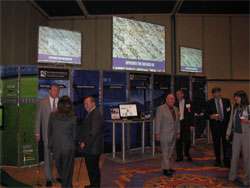Reminder: Your MLA Notice Must Have Your License Number
November 26, 2014 —
Christopher G. Hill – Construction Law MusingsRemember a couple of years ago when the Virginia mechanic’s lien rules changed to require inclusion of a claimant’s contractor’s license number (where a license is required)? If not, then this is a reminder of that particular wrinkle in the strictly interpreted mechanic’s lien statute. This requirement applies to all mechanic’s lien memoranda and, like all parts of this crazy statute, will invalidate a lien if not met. Well, another change to the statute happened with a bit less fanfare.
The change back in 2013 that came along with the license number requirement for a lien memorandum is a change in the mechanic’s lien agent notice requirement that applies to residential construction. The basic requirement, namely that those performing residential construction must notify any mechanic’s lien agent (“MLA”) listed on a building permit within 30 days of starting work that they are on the job and could file a lien, has not changed. What the amendments to the lien statutes in 2013 added was a requirement that the notice, like a lien memorandum, must include the contractor’s or subcontractor’s license number.
Read the court decisionRead the full story...Reprinted courtesy of
Christopher G. Hill, Law Office of Christopher G. Hill, PCMr. Hill may be contacted at
chrisghill@constructionlawva.com
2011 West Coast Casualty Construction Defect Seminar – Recap
June 01, 2011 —
CDJ STAFF �  | �
�| Event exhibitors and sponsors contribute to an informative and engaging environment | �
�This year’s meeting was the best yet for the industry-leading construction defect and claims event.
�This year’s seminar concluded on May 13, 2011 with the Construction Defect Community Charitable Foundation Golf Tournament, held at Strawberry Farms Golf Course.
�The Disneyland Hotel in Anaheim, California was the place where more than 1,500 attendees convened for two days of professional development activities and seminars that included CLE workshops and panel discussions of special interest to legal and insurance professionals concerned with construction defect and claims litigation. Key events included “Challenges for Experts in Construction Defect Claims and Litigation,” “Keeping Up with Construction Defect Coverage,” and “Tips for Avoiding the ‘Perfect Storm’ in Handling of Wrap Claims.”
� �  | �
�| Supporting the golf tournament at the 15th hole | �
�This year’s Ollie award was given to George D. Calkins II, Esq. The West Coast Casualty Jerrold S. Oliver Award of Excellence was named in honor of the late Judge Jerrold S. Oliver, and recognizes an individual who is outstanding or has contributed to the betterment of the construction community.
�In addition to being the most comprehensive professional development seminar in the area of construction defects, this year’s seminar was equally valuable as a networking opportunity for members of the industry. People participated in professional development events during the day and then continued networking in the evening at numerous social events. The Lawn Party as well as the legendary Wood, Smith, Henning & Berman events were very well attended. Additional valuable networking events were hosted by a number of industry professionals at the House of Blues, and Tortilla Joe’s.
�As of this writing the 2011, West Coast Casualty's Construction Defect Seminar has applied for or has already received the following continuing education accreditation in the following areas;
�Read the full story…
�For more information about next year’s event, visit West Coast Casualty.
Read the court decisionRead the full story...Reprinted courtesy of
Bill Proposes First-Ever Federal Workforce Housing Tax Credit for Middle-Class Housing
March 04, 2024 —
Emily K. Bias & Brittany Griffith - Gravel2Gavel Construction & Real Estate Law BlogLegislation was recently introduced to the U.S. Senate and House of Representatives proposing the creation of the first-ever Workforce Housing Tax Credit (WHTC) for middle-income housing developments.
Similar to the existing Low-Income Housing Tax Credit (LIHTC), the WHTC would provide additional federal income tax credits to housing development projects for tenants making between 60% and 100% of Area Median Income (AMI). The allocation of WHTC would be based on a competitive bid process and awarded to developments over a 15-year credit period (as opposed to a 10-year credit period for LIHTC). Developments receiving allocations of WHTC will be subject to affordability requirements during the 15-year credit period and subsequent extended use period of at least 15 years.
Reprinted courtesy of
Emily K. Bias, Pillsbury and
Brittany Griffith, Pillsbury
Ms. Bias may be contacted at emily.bias@pillsburylaw.com
Ms. Griffith may be contacted at brittany.griffith@pillsburylaw.com
Read the court decisionRead the full story...Reprinted courtesy of
Coverage Issues: When You Need Your Own Lawyer in a Construction Defect Suit
October 16, 2013 —
CDJ STAFFWhen an insurer hires an attorney on behalf of a client in a construction defect suit, that attorney is the client’s lawyer, but as Mike Curry writes on the website of Pendleton Wilson Hennessey & Crow, PC, a point may come when you need to hire your own additional attorney. Even though an insurance company client may refer to the lawyer as “the insurance carrier’s attorney,” Mr. Curry cites the words of the Colorado Bar Association’s ethics committee, “the insured is the client to whom the lawyer’s duty of loyalty is owed, regardless of any retention agreement the lawyer may have with the carrier.”
Mr. Curry then offers the example of what happens when the insurance company advises its client that it may not cover. “You presumably call your attorney and ask him to explain what’s going on, what the letter means, and what to do next.” All the attorney can say is “I cannot offer legal advice on coverage issues.”
This is the limitation of what Mr. Curry refers to as “the tripartite relationship.” The attorney has been retained for issues related to the construction defect dispute between the insured and the plaintiff. Not between the insurer and its insured. The attorney has, as he points out, a fiduciary obligation to the insurance company.
When coverage issues arise, “an independent attorney — one you hire — can help you with the coverage issues that your insurance-assigned attorney simply cannot address.” He further notes that “personal counsel owes no fiduciary obligation to the insurance company,” and can be “utilized to persuade the carrier to provide coverage or settle the case.”
Read the court decisionRead the full story...Reprinted courtesy of
User Interface With a Building – Interview with Esa Halmetoja of Senate Properties
September 14, 2017 —
Aarni Heiskanen - AEC BusinessArchitect Mies van der Rohe once said that, “An office is a machine for working in.” From a maintenance person’s point of view that might be true. For a user, an office should offer a productive working environment. A pilot project, led by Esa Halmetoja of Senate Properties, is trying to find out how a digital twin of a building would serve both the needs of the maintenance worker and the office worker.
Read the court decisionRead the full story...Reprinted courtesy of
Aarni Heiskanen, AEC BusinessMr. Heiskanen may be contacted at
info@aepartners.fi
Appellate Division Confirms Summary Judgment in Favor of Property Owners in Action Alleging Labor Law Violations
June 19, 2023 —
Lisa M. Rolle - Traub LiebermanIn this action brought before the State of New York, Appellate Division, Traub Lieberman Partner Lisa Rolle represented Defendant Property Owners in an appeal asserting Labor Law violations. In the underlying case, Plaintiff allegedly was injured while working on a construction project at a property owned by the Defendants, alleging violations of Labor Law §§240(1) and 241(6). The Defendants moved for summary judgment dismissing the causes of action alleging violations of Labor Law §§ 240(1) and 241(6), arguing that they could not be held liable for such violations due to the exemption set forth in those statutes for owners of one- and two-family dwellings. The Supreme Court of the State of New York granted the motion for summary judgment, and the Plaintiffs appealed.
Read the court decisionRead the full story...Reprinted courtesy of
Lisa M. Rolle, Traub LiebermanMs. Rolle may be contacted at
lrolle@tlsslaw.com
Specification Challenge; Excusable Delay; Type I Differing Site Condition; Superior Knowledge
January 02, 2024 —
David Adelstein - Florida Construction Legal UpdatesAn Armed Services Board of Contract Appeals dispute, Appeal of L.S. Black-Loeffel Civil Constructors JV, ASBCA No. 62402, 2023 WL 5827241 (ASBCA 2023), involved which party bore liability for delay—the federal government or the prime contractor–based on various legal theories. Without detailing the factual details, a number of interesting legal issues were raised in this dispute including (1) a defective specification challenge, (2) excusable delay, (3) Type I differing site condition, and (4) superior knowledge. These legal issues are discussed below.
1. Specification Challenge (Defective Specifications)
The contractor claimed that the government’s specifications were defective in regard to a thermal control plan. The government countered that the specifications were not design specifications but performance specifications. The specifications were performance based because they did not tell the contractor how to achieve the performance-based criteria.
Read the court decisionRead the full story...Reprinted courtesy of
David Adelstein, Kirwin Norris, P.A.Mr. Adelstein may be contacted at
dma@kirwinnorris.com
Insurer Entitled to Reimbursement of Defense Costs Under Unjust Enrichment Theory
May 04, 2020 —
Tred R. Eyerly - Insurance Law HawaiiThe federal district court for the district of Hawaii determined that the insurer could recover defense costs from an additional insured consistent with its Reservation of Rights letter under an unjust enrichment theory. Giga, Inc. v. Kiewit Infrastructure W. Co., 2020 U.S. Dist. LEXIS 10151 (D. Haw. Jan. 22, 2020).
This case was related fall-out from the Arthur case. Arthur v. Dept. of Hawaiian Homelands, 185 Haw. 149 (Haw. Ct. App. 2015). A prior post on the case is here.
In Arthur, a resident, Mona Arthur, of the Kalawahine Streamside Housing Development, was killed when she apparently slipped and fell from a hillside adjacent to the project. She was on the hillside tending to her garden there. At the bottom of the hill was a two foot fence in front of a drainage ditch, where Mona allegedly hit her head.
Mona's husband, William Arthur, sued a variety of defendants including the land owner, designer, developer, civil engineer and others. William alleged the defendants were negligent in the design, construction and supervision of the construction of the hillside area.
Read the court decisionRead the full story...Reprinted courtesy of
Tred R. Eyerly, Damon Key Leong Kupchak HastertMr. Eyerly may be contacted at
te@hawaiilawyer.com




































































